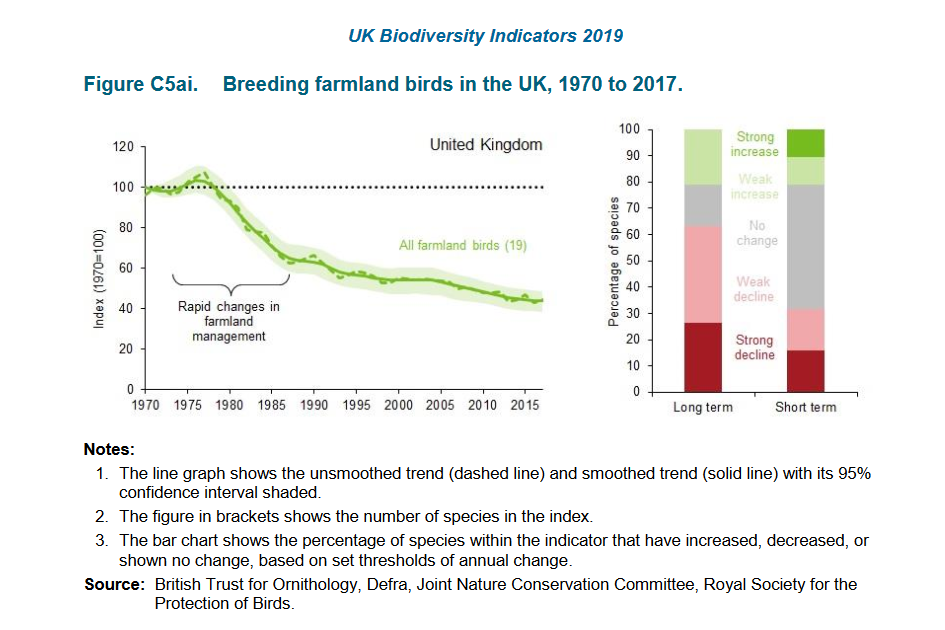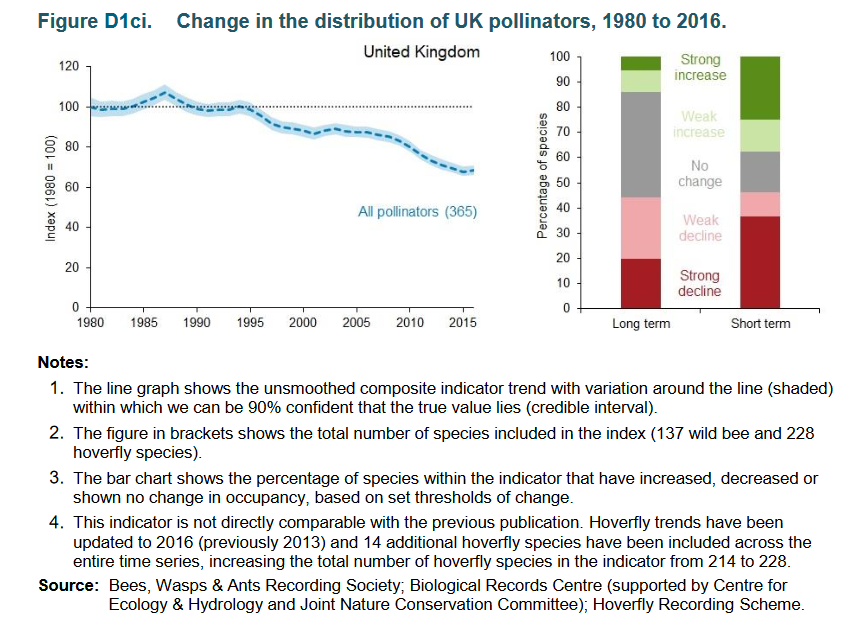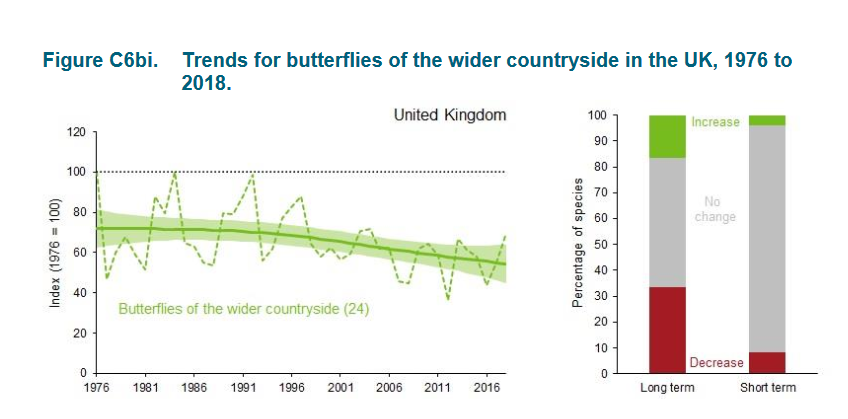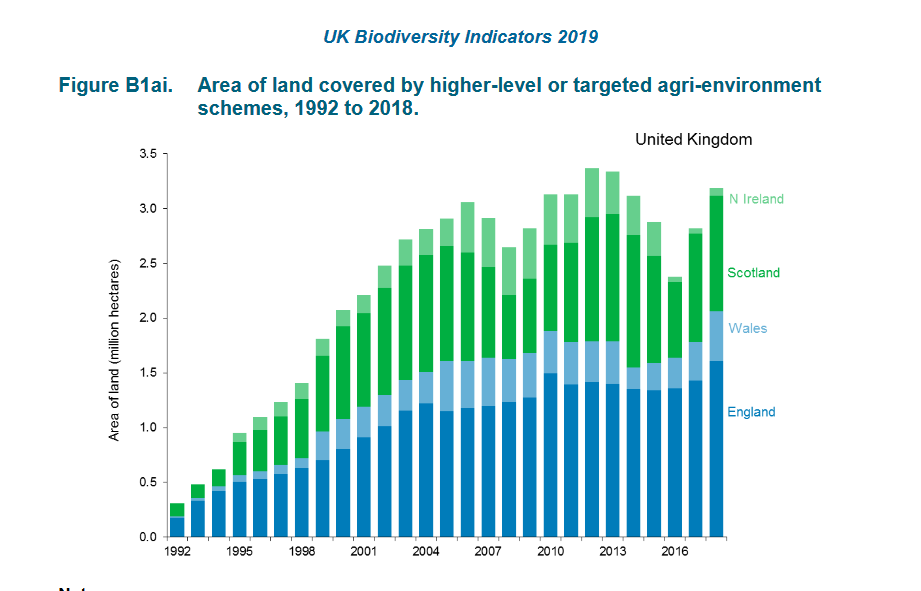Last week, the latest UK Biodiversity Indicators were published. Did you see the government press release about them? Did you hear Defra ministers quizzed about them on every news bulletin through the day? Is this the first you have heard of them?
I’m fond of these indicators for two main reasons. First, government ought to publish statistics on what is actually happening and be held to account for what they have failed to achieve and praised for what they have achieved. Second, I, and many others, spent a lot of time back in the 1990s (yes, really!) persuading a Labour Government to adopt these indicators (or a set very similar to them) and so their very existence is a small source of pleasure for me.
But when they were launched, the idea was that they would form sustainability indicators which would be prominent measures of government progress to be compared with economic measures such as GDP, inflation, employment, manufacturing output etc. That hasn’t really happened has it? It did for a while, I remember Elliot Morley, as a Minister of State, doing several press conferences on the day that these statistics were released and being put on the spot by journalists from all the national dailies about why farmland birds were doing so badly despite being an indicator of sustainability and these results being given real prominence in the media.
I remember (and I’ve told this story before but you won’t remember it) back in the mists of time, when we didn’t know that Ed Balls could dance, and when he was Chancellor Gordon Brown’s Special Advisor in the Treasury, being at a meeting when Ed was asked why on earth the government had a measure about how birds were doing – who cares? Ed’s answer was perfect (for those of us who had been bending government’s collective ears on this matter for years) and was two-fold along these lines. First, people do care about wildlife – don’t you know that wildlife conservation groups have more than six million members and that the RSPB has over a million – that’s more than all the political parties in the UK put together? But second, a countryside whose wildlife is declining cannot be being managed sustainably and we need to look at those figures hard and do something to turn them around. Result!
When the Conservative-led (or misled) coalition government came in (in 2010) they immediately down-graded these measures in importance and now they can be published with precious little scrutiny or comment. That is, in itself, one of the strongest biodiversity trends over this period; a big rise in government nonchalance about the state of nature on their watch.
So, today, I will post a series of blogs about the indicators and what they mean. Several of the indicators will crop up more than once in this short series of blogs as we go through the day, but let us start with that farmland bird indicator – how is it doing after all these years?

Not exactly a graph that signals great achievement, is it? If Therese Coffey works as assiduously and successfully in her new Cabinet post (Department of Work and Pensions) and has the same impact on her new brief as she and her predecessors have on farmland bird numbers we can expect the results to be all over the media.
And it’s not just birds that are doing badly on farmland;

And here’s another one;

And yet, we are spending lots of money rewarding farmers for what they are doing for the environment:

Nothing could demonstrate much more starkly that, in what is called the wider countryside, the combined efforts of farmers, landowners and government policy have failed to turn around the decline in biodiversity and that our money has been a poor investment. How I wish that Therese Coffey and George Eustice had been grilled on the Today programme and every subsequent news programme through the day about why their government had failed, how they justified their salaries and what their successors should do to correct their failure. But the media don’t have the wit to spot an environmental story which isn’t a filler between ‘real’ news these days.
More later today – and it’s not all bad news (just mostly bad news).
[registration_form]
I thought it particularly ironic, given the lack of fanfare in publishing the results, that the indicator for ‘awareness of biodiversity and understanding of its value’ has been removed.
Maybe Defra could take some responsibility for the lack of awareness?
An excellent article, thanks Mark
It is appalling how little attention such important figures receive in wider society. The only good news I could see in your blog is that Theresa Coffey is no longer in Defra!
Whether or not that is good news rather depends on who her successor turns out to be. It might be difficult to get someone worse but there’s plenty of scope for just as bad 🙁
Yes, except that is absolutely terrible news for the victims of her promotion.
Her voting record on DWP issues is just plain sick. The fact that she got promoted is just another mad episode to add to this weeks insanity.
https://twitter.com/search?q=coffey%20voting%20record&src=typd
https://rightsinfo.org/therese-coffey-work-pensions-human-rights-record/
Mark’s blog very depressing but essential reading. Thanks Mark for reaching the parts others don’t reach. I have to be careful about forwarding news to this to my friends who already seem to be in a permanent state of rage and/or hopelessness as i do.
But we must keep on fighting.
This is more complete
https://www.theyworkforyou.com/mp/24771/therese_coffey/suffolk_coastal/votes
Desperately depressing Mark. As if there wasn’t enough bad news around at the moment. Maybe the light at the end of the tunnel could be produced eventually by a general election.
But surely ‘the light at the end of the tunnel is the light of an oncoming train’ ? (and extra points for anyone who knows without looking up which band that lyric belongs to…)
Depressing but not entirely unexpected. Perhaps when we ( if we do) cast ourselves adrift from our friends and neighbours across the Channel/North Sea government( lets hope its not this one) will be modifying the way we subsidise the wider countryside to actually provide some real changes for the better in conservation of our fellow creatures and habitats. After all it is what we are supposed to be using this tax payers money for!
To put it in context the land under agri-environment schemes
I wanted to know how many hectares of agricultural land in the UK .
Apparently it’s just over 9 million hectares. https://assets.publishing.service.gov.uk/government/uploads/system/uploads/attachment_data/file/654742/structure-jun2017final-eng-26oct17.pdf
So about a third of the land is in these schemes ,presumably mostly upland and other grassland.
But compared to other countries is this a high or low percentage?
I’m sure someone will tell me if I’ve got this wrong
Gary – a-e schemes are different, now in different UK countries, let alone different EU countries, and the graph refers only to the higher tier (best, but also most expensive) schemes. Member states have always had the power to devise their own schemes (and to some extent decide how much money goes into them) so the failure of our schemes to conserve our birds is our fault.
That’s some decline between 1976-86. What prompted that I wonder? Was it connected to the 1975 referendum? When Mr Wislon asked whether we wanted to stay or leave the EEC. I was told by my employer to vote to stay. I voted leave. I lost.
We stayed and the directors awarded themselves new Jaguars and trebles all round, for they knew the CAP would milk the taxpayer and fund a glorious farming revolution based on guarantees of a floor price for everything and after all we had a lot of empty aircraft hangars left over from The War that needed surpluses to put in them so why not let the lending and ploughing and fertilising and seeding begin and there’s a Song Contest as well.
filbert – as I’m sure you know, it was rather more related to the overall intensification of agriculture and particularly the switch from spring to autumn sowing made possible by new herbicides.
There was no nice simplistic Big Red Control Knob. Tribunil & IPUs were certainly effective herbicides but that’s just one element. Winter cereals were always important and the more N you threw at them the more they would yield if you could keep them keep them propped up with growth regulators. They didn’t work well on winter barley so Hey Presto Ackermann releases Igri with only 2 rows and nice short straw and outyielding spring barley by x2. Spring barley almost wiped out within a few years. The EEC decided it wanted more edible oil production so in pretty quick time we had shorter strawed oilseed rape without erucic acid and glucosinolate content. Winter cropping takeover complete. Mixed farming almost gone from the east. You know, the sort that has cowpats.
The overall intensification of agriculture in the UK was facilitated by membership of the EEC. It was funded by banks lending farmers money because their managers could calculate with confidence the expected farm income based on only moderate yields and fixed intervention prices courtesy of the CAP. The more they grew the more they were paid – simples!
Filbert – well, I agree that there was no Big Red Control Button and what you describe sounds like a mixture of finance and technological change to me. I’m happy to go with that. For birds it was the loss of winter stubble fields, increase in silage production, clobbering of insects etc that did the trick. And mixed farming went from the west too – you know, the sort that had crops?
If it possible to see the indicators just for the subset of land which is in agri-environment schemes? Given the fortune we are paying for that stuff, we should at least get rising indicators for those areas. And if they are not big enough or connected enough on their own to lead to a rise, then what is the point of them?
m parry – the data won’t be collected at that resolution – so, no! Monitoring costs would be prohibitive but I think that all the prescriptions have been tested and work. The problem is that there aren’t enough farms engaged in the best actions and too many farms still doing things that drive biodiversity downwards.
Also not enough follow-up to check that farmers are following the prescriptions and not enough action when they’re not. All the targets are to get land into agreement not about quality of outcome.
Increasingly, the only surprise is that conservationists have behaved as if the Conservatives actually cared a dam – they don’t, and we are living in the lost decade when we could have changed course and haven’t. Labour’s extraordinary efforts to trash their own record as faction fights faction is equally bizarre – Labour di try and achieved quite a lot, for example the condition of SSSIs, but equally failed in the wider countryside. Yet NFU today are still claiming total ownership of the countryside with a claim today that farming can be carbon neutral & go on producing excessive amounts of meat if only they grow lots and lots of (intensive, wildlife free) energy crops.